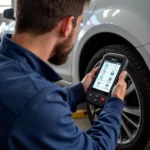Understanding which vehicles are OBD2 compatible is crucial for any car owner interested in DIY diagnostics and repairs. OBD2, which stands for On-Board Diagnostics, second generation, is a standardized system that allows external electronics to interface with a vehicle’s computer system and access valuable data about its engine, emissions, and other key components. But what vehicles utilize this technology? Let’s dive in.
What Makes a Vehicle OBD2 Compatible?
The transition to OBD2 compatibility wasn’t immediate. While the technology was introduced in the early 1990s, it wasn’t until specific mandates that it became the standard. Here’s a breakdown:
- 1996 and Newer US Vehicles: All gasoline-powered cars and light trucks sold in the US from 1996 onward are OBD2 compliant.
- 2001 and Newer Diesel Vehicles in the US: The OBD2 mandate for diesel vehicles came slightly later, requiring compliance from model year 2001.
- European and Other Regions: Europe adopted OBD2 (known as EOBD) on gasoline vehicles starting in 2001 and diesel vehicles in 2004. Other regions have their own timelines and standards, often aligned with US or European regulations.
 OBD2 Port Location
OBD2 Port Location
How Can I Tell if My Vehicle is OBD2 Compliant?
There are a few ways to determine if your vehicle is OBD2 compatible:
- Check the Vehicle Identification Number (VIN): The tenth digit of your VIN indicates the model year. If your car’s VIN has a ‘T’ or a ‘V’ as the tenth digit, it signifies a 1996 or 1997 model year respectively, making it OBD2 compliant.
- Look for the OBD2 Port: The OBD2 port is a 16-pin trapezoidal connector usually located under the dashboard on the driver’s side. You can visually inspect this area for the port.
- Consult Your Owner’s Manual: Your vehicle’s owner’s manual will usually specify if your car is OBD2 compliant, often within the emissions or engine diagnostics sections.
Benefits of Owning an OBD2 Scanner for Compatible Vehicles
For owners of OBD2 compatible vehicles, investing in a cheapest obd2 reader walmart can be incredibly beneficial. Here’s why:
- Diagnose Check Engine Light: Easily identify the reason behind a lit check engine light, saving time and potential misdiagnoses at a mechanic.
- Monitor Vehicle Performance: Track engine parameters, fuel economy, emissions data, and other vital signs for a comprehensive understanding of your car’s health.
- Reset Warning Lights: After addressing a problem, OBD2 scanners can reset warning lights like the check engine light.
- Cost Savings: Catching issues early with an OBD2 scanner can prevent minor problems from escalating into costly repairs.
“Every car owner with an OBD2 compatible vehicle should consider having a scanner,” says automotive engineer, Sarah Chen. “It’s a powerful tool that empowers you to understand your car better and potentially save significant money on repairs.”
Common Questions About OBD2 Compatible Vehicles
Q: Are all OBD2 scanners compatible with all OBD2 vehicles?
A: While the port itself is standardized, some scanners might have software limitations. It’s always best to check the scanner’s compatibility list before purchasing.
Q: Can I use an OBD2 scanner to program keys or change vehicle settings?
A: Basic OBD2 scanners focus on diagnostics. More advanced functions typically require specialized equipment.
Q: What is the difference between OBD1 and OBD2?
A: OBD2, introduced in 1996, offered a standardized system with a universal connector and wider data access compared to its predecessor, OBD1.
Expanding Your OBD2 Knowledge
Understanding OBD2 compatibility opens a world of possibilities for vehicle diagnostics and maintenance. For those interested in taking their knowledge further, explore our in-depth reviews on the viecar 4.0 bluetooth elm327 obd2 scanner for android ios or delve into the fascinating realm of chiptuning box obd2. For a deeper understanding of the technology itself, our article on the obd2 elm327 bluetooth can bus interface provides valuable insights.
Conclusion
In conclusion, if you own a vehicle manufactured in the US after 1996 or a European model from the early 2000s onwards, it is highly likely that your car is OBD2 compatible. Embracing the power of OBD2 technology through a compatible scanner empowers you with knowledge, control, and potential cost savings in your vehicle ownership journey. Don’t hesitate to explore the world of OBD2 scanners and unlock a new level of understanding about your car’s health and performance.
For further assistance or any inquiries, our dedicated customer support team is available 24/7 via WhatsApp: +1(641)206-8880 or Email: [email protected]. Let us help you navigate the world of OBD2 with confidence!

